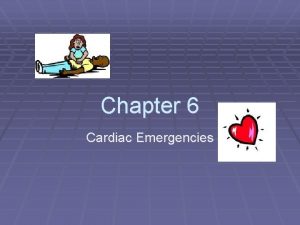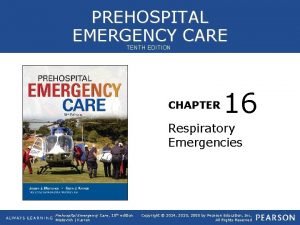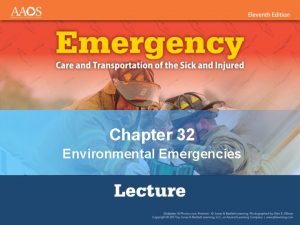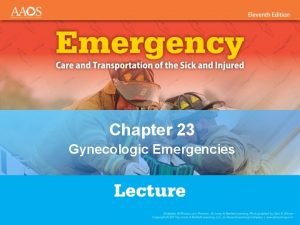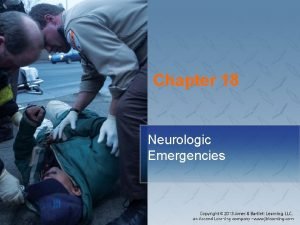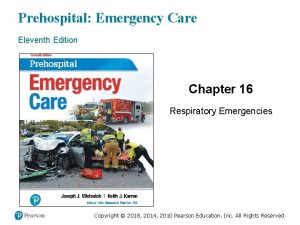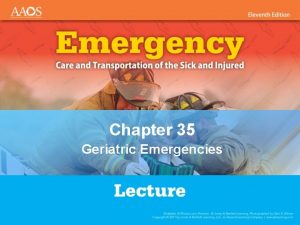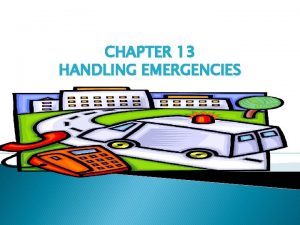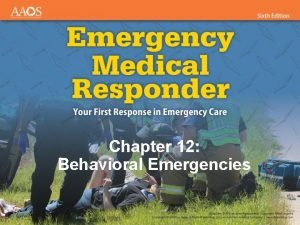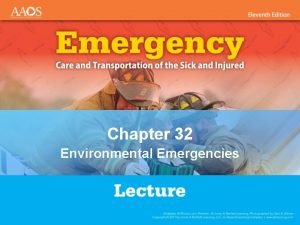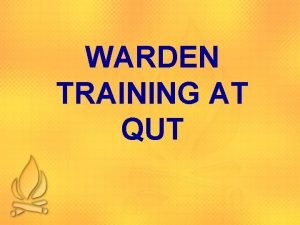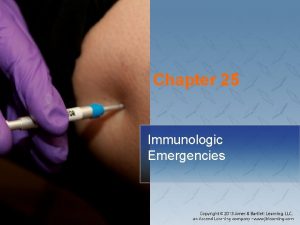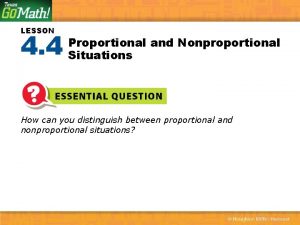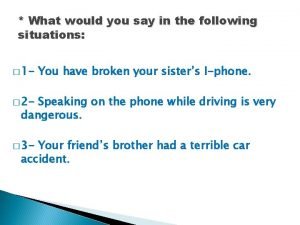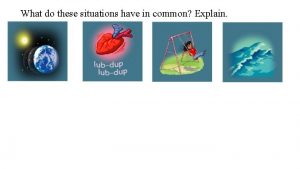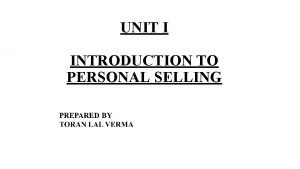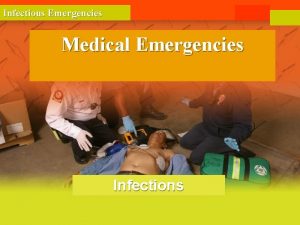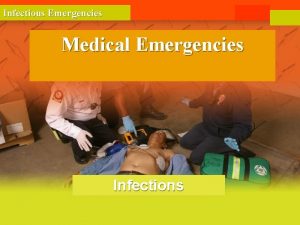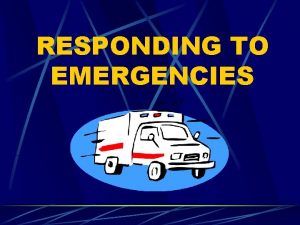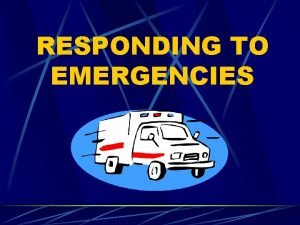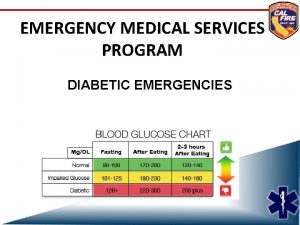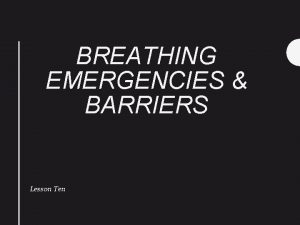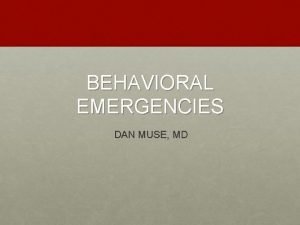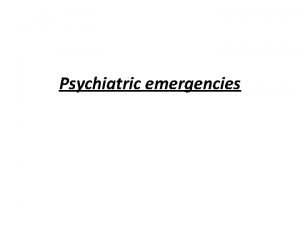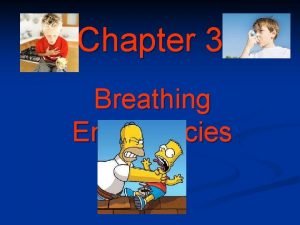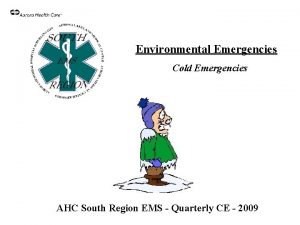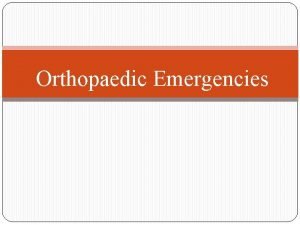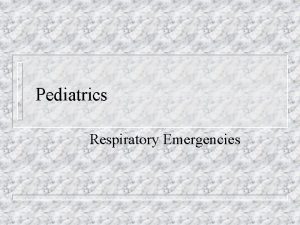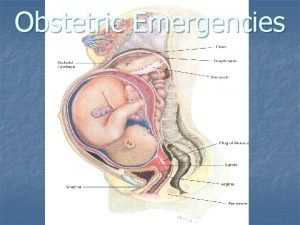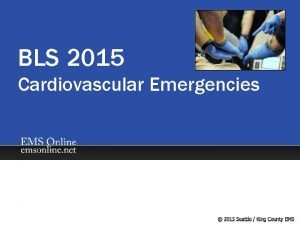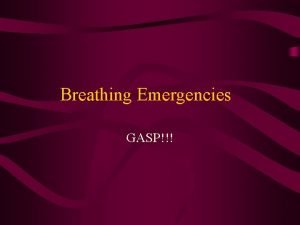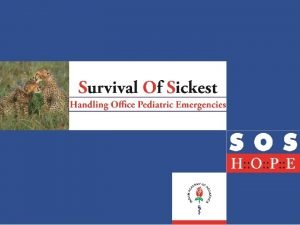EMERGENCY SITUATIONS Emergency Situations Lesson 1 EMERGENCIES Emergency


























- Slides: 26

EMERGENCY SITUATIONS

Emergency Situations: Lesson 1 EMERGENCIES

Emergency Vehicles If emergency vehicle Pull as far to right as practical approaching you from and yield (unless opposite front or rear on a direction on divided highway) roadway: Approach with caution If you are approaching Make a lane change into lane a stationary not immediately adjacent to emergency vehicle: emergency vehicle (if available) If not practical, pass with caution in adjacent lane

Roadside Emergencies Basic Steps Move off roadway to safe location Turn on hazard lights/flashers. Avoid parking on the shoulder of the road if possible. Secure coach Set parking brake, shut engine off. Manage passengers Communicate with passengers; ask to remain on-board unless evacuation required. Must be placed within 10 minutes of Place warning devices stopping on any shoulder or travel portion of a highway.

Warning Device Placement • Always place 3 warning devices • Placement locations dependent on the characteristics of roadway where coach is located • Divided highway or one-way road • Two-way, undivided roadway • Within 500 ft. of curve, hill, or other view obstruction that prevents oncoming traffic from seeing parked CMV

Warning Device Placement Divided Highway/One-Way Roadway

Warning Device Placement Two-Way/Undivided Roadway

Warning Device Placement Two-Way Roadway with Sight Restriction

Breakdowns • Sometimes can be avoided or anticipated by attentive drivers – Pay attention to changes in feel and operation, such as vibrations or performance – Pay attention to warnings and gauges – Take note of unusual noises – Report specific issues on VIRs Do not ignore signs & warnings of potential issues simply because the coach still runs

General Diagnostics Symptom Indications Engine overheating Coolant Engine belt broken or displaced off temperature gauge; pulley; low on coolant; low on oil Coolant/engine light Vibration Unusual shaking of coach/wheel Flat tire; loose lug nuts; wheel bearing issue; unbalanced wheel; cracked crankshaft Engine does not crank Battery disconnect switch is off; Transmission not in Neutral; Rear remote starter switch off; Front starter bad; Battery loose; Electrical problem Engine cranks Rear ignition switch not set properly; Out of fuel. Won’t start Potential Causes

Breakdown: Worse Case Scenario • Breakdown in area without any cellular service. How to get help? – Seek help from nearby business or resident – Secure assistance from a passing motorist – Flag down a truck with a CB – Wait (hope) for police to stop

Crashes • Compose yourself, try to remain calm • Call 911 and/or company • Move coach to safe area off roadway, if possible – Place warning devices if on/near roadway • Render reasonable assistance to injured persons

Crash Information • Driver responsibilities include information gathering. Examples: – Passenger details (name/contact info/statement) – Details of other parties involved – Name & contact information of other witnesses – Responding police agency – Location details – Photographs – Fuel/fluid release

Post-crash Testing • DOT regulations require post-crash drug and alcohol testing following serious crashes that meet specific criteria • Your company may have internal policies requiring post-crash testing in additional circumstances Never consume any alcohol or drugs following a crash

Serious Issues While Driving • Tire blowouts (especially steer) • Brake Failures • Bus Fires • Leaving the roadway To successfully handle a serious situation, you must be mentally prepared. Know how to react!

Tire Failures • Pay attention to unusual vibrations and investigate them immediately • If you have a sudden failure: 1. Stay off the brake; grip steering wheel but do not steer until speed diminishes 2. Activate hazards 3. Coast until under 20 mph 4. Turn off roadway and stop in a safe location

Brake Failure • Air brake system failures will usually be indicated by the low air warning sound and light. If occurs: – Activate hazards and reduce transmission gear manually to lower gears, slowing coach. – Do not attempt using the brake until you are ready to stop – you will have limited brake application ability

Bus Fires • Bus can become engulfed very quickly – Less than 10 minutes! • Engine and wheel fires most common Potential Fire Indicators Loss of power/sluggish bus Unusual heat build up around wheels Unusual smells Passenger complaints Passing motorists signals Unusual glitches/malfunctions

Bus Fires: What to Do Turn off HVAC Stop coach Turn off engine Evacuate

Leaving Roadway • Avoid abrupt steering reactions if you leave the roadway – If on paved or gravel shoulder, steer slightly back toward roadway – If leave roadway into soft terrain, must reduce speed before steering • Steering input in soft terrain at significant speeds = increased rollover potential

Passenger Evacuation • Brief passengers – why and how • Direct evacuating passengers where to go once off motorcoach (safe location off roadway) • Assist any non-ambulatory or mobility-impaired passengers off coach Recruit a passenger for assistance in leading group to designated area and keeping group together (when necessary)

Passenger Management • Detail instructions/actions with regard to belongings during evacuations • Try to keep passengers together • Keep on-board in nonevacuation situation – Use best judgment regarding requests to step off

Aggressive Motorists • Do not retaliate to enrage further • Slow down to allow them to move on • Consider an unscheduled stop if necessary • Never permit on-board if stopped and they approach • Call 911 if necessary

Unruly/Aggressive Passenger Dangerous/ threatening behavior Behavioral disruption/ distraction Do what is necessary to ensure safety for passengers and yourself, including unscheduled stops and halting of trip Work with company and/or authorities to arrange for passenger to be removed Ask passenger to discontinue (enlist group leader assistance if present) Pull over to safe area and address entire group if necessary

Hijack or Hostage Golden Rule: Do as instructed/follow directions. While following the Golden Rule, consider the following: 1. Utilize any on-board silent, electronic distress signals 2. IF opportunity to communicate with dispatch, use code word or talk strangely 3. Silently and inconspicuously use driving behavior and/or vehicle lighting to attract attention from other motorists 4. Try to ask for bathroom stop or stop to check bus condition 5. Dial 911 on cell phone if can be done inconspicuously and leave line open

Other Emergencies Other Security Concerns • Call 911 • Evacuate bus if concern warrants Passenger Illness • Move to visible and accessible location • Call 911 • Find safe haven for passengers Extreme Weather • Notify dispatch of your location
 Lesson 6: cardiac emergencies and using an aed
Lesson 6: cardiac emergencies and using an aed Local area orientation dive
Local area orientation dive Chapter 16 respiratory emergencies
Chapter 16 respiratory emergencies Major nutritional deficiency diseases in emergencies
Major nutritional deficiency diseases in emergencies Environmental emergencies emt
Environmental emergencies emt Chapter 23 gynecologic emergencies
Chapter 23 gynecologic emergencies The term behavioral crisis is most accurately defined as
The term behavioral crisis is most accurately defined as Chapter 19 endocrine and hematologic emergencies
Chapter 19 endocrine and hematologic emergencies Chapter 18 neurologic emergencies
Chapter 18 neurologic emergencies Emt chapter 18 gastrointestinal and urologic emergencies
Emt chapter 18 gastrointestinal and urologic emergencies Chapter 28 first aid and emergencies
Chapter 28 first aid and emergencies Chapter 16 respiratory emergencies
Chapter 16 respiratory emergencies Dic labs
Dic labs Chapter 35 geriatric emergencies
Chapter 35 geriatric emergencies Chapter 13 handling emergencies
Chapter 13 handling emergencies Chapter 12 behavioral emergencies
Chapter 12 behavioral emergencies Chapter 32 environmental emergencies
Chapter 32 environmental emergencies Chapter 17 cardiovascular emergencies
Chapter 17 cardiovascular emergencies Psychiatric emergency
Psychiatric emergency Qut security contact number for emergencies
Qut security contact number for emergencies Immunologic emergencies
Immunologic emergencies Chapter 17 neurologic emergencies
Chapter 17 neurologic emergencies Lesson 4 proportional and nonproportional relationships
Lesson 4 proportional and nonproportional relationships 4.4 proportional and nonproportional situations
4.4 proportional and nonproportional situations What would you say for the following situation
What would you say for the following situation What do you they have in common explain
What do you they have in common explain Personal selling situations
Personal selling situations
